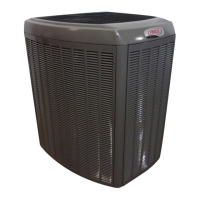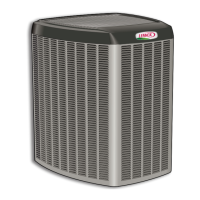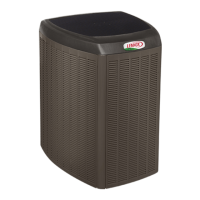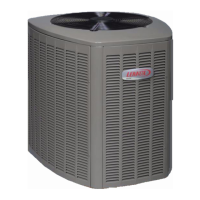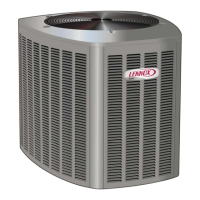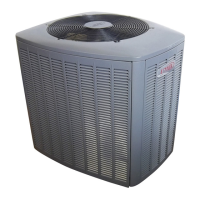Page 27
Sequence of Operation XP19−024/060
First Stage Cool (low capacity)
Transformer from indoor unit supplies 24VAC power to
the thermostat and outdoor unit controls.
1− Internal wiring energizes terminal O by cooling mode
selection, energizing the reversing valve. Cooling de-
mand initiates at Y1 in the thermostat.
2− 24VAC passes through high pressure switch S4 and
discharge thermostat switch S5 energizing compres-
sor contactor K1.
3− K1−1 N.O. closes energizing compressor B1 and out-
door fan motor B4.
4− Solenoid L34 is NOT energized. The slider ring re-
mains open limiting compressor to low capacity.
Second Stage Cool (high capacity)
5− Second stage thermostat demand sends voltage to the
LSOM. After a 5 second delay the LSOM converts the
AC voltage to DC voltage and energizes solenoid L34.
L34 then closes the slider ring, allowing the compres-
sor to operate at high capacity. Variable speed outdoor
fan operates on high speed (blue tap).
Heating
A – Low Capacity
1 − Room thermostat in heating mode. Room thermostat
outputs Y1 signal to the defrost board in the heat pump
and to the indoor air handler.
2 − The defrost board checks for open low or high−pres-
sure switches and proper coil, ambient and discharge
sensor readings. If checks show no issues, the defrost
board sends 24 volts through Y1 OUT signal to the K1
compressor contactor coil, the Y1 terminal on the diag-
nostic module (A132) and the yellow wire to the out-
door fan motor.
3 − K1−1 closes, energizing the compressor and puts 240
volts into the outdoor fan motor through the normally
closed fan relay contacts on the defrost board.
4 − The compressor will run on low capacity and the 24volt
input on the yellow wire to the outdoor fan motor will al-
low it to run on low speed.
B – High Capacity (Ambient temperature above
de-
frost board Y2 lock−in temperature)
1 − Room thermostat in heating mode. Room thermostat
outputs Y1 and Y2 (if applicable to that room thermo-
stat) signal to the defrost board in the heat pump and to
the indoor unit.
2 − The defrost board checks for open low or high−pres-
sure switches and proper coil, ambient and discharge
sensor readings. If checks show no issues, the defrost
board sends 24 volts through Y1 OUT signal to the K1
compressor contactor coil, the Y1 terminal on the diag-
nostic module (A132) and the yellow wire to the out-
door fan motor.
3 − The defrost board sends 24 volts through Y2 OUT sig-
nal to the Y2 terminal on the diagnostic module (A132)
and the blue wire to the outdoor fan motor.
4 − K1−1 closes, energizing the compressor and puts 240
volts into the outdoor fan motor through the normally
closed fan relay contacts on the defrost board.
5 − The compressor will run on low capacity for 5 seconds.
The diagnostic module (LSOM) will confirm low stage
operation and then output a 24volt DC signal to the L34
internal high capacity solenoid valve in the compres-
sor. Once the solenoid is energized, the diagnostic
module will continue pulsing 6 to 18 volt DC signal to
the solenoid to keep it energized during the Y2 room
thermostat demand.
6 − The 24volt inputs to the yellow and blue wires of the
outdoor fan motor will provide high−speed operation.
B – High Capacity (Ambient temperature below
de-
frost board Y2 lock−in temperature)
1 − Room thermostat in heating mode. Room thermostat
outputs Y1 signal to the defrost board in the heat pump
and to the indoor unit.
2 − The defrost board checks for open low or high−pres-
sure switches and proper coil, ambient and discharge
sensor readings. If checks show no issues, the defrost
board sends 24 volts through Y1 OUT signal to the K1
compressor contactor coil, the Y1 terminal on the diag-
nostic module (A132) and the yellow wire to the out-
door fan motor.
3 − The defrost board Y2 locks in
sends 24 volts through
Y2 OUT signal to the Y2 terminal on the diagnostic
module (A132) and the blue wire to the outdoor fan mo-
tor.
4 − K1−1 closes, energizing the compressor and puts 240
volts into the outdoor fan motor through the normally
closed fan relay contacts on the defrost board.
5 − The compressor will run on low capacity for 5 seconds.
The diagnostic module (LSOM) will confirm low stage
operation and then output a 24volt DC signal to the L34
internal high capacity solenoid valve in the compres-
sor. Once the solenoid is energized, the diagnostic
module will continue pulsing 6 to 18 volt DC signal to
the solenoid to keep it energized during the Y2 opera-
tion.
6 − The 24volt inputs to the yellow and blue wires of the
outdoor fan motor will provide high−speed operation.
Defrost Mode
When a defrost cycle is initiated, the control ener-
gizes the reversing valve solenoid and turns off the
condenser fan. The control will also put 24VAC on
the W1" (auxiliary heat) line. The unit will stay in this
mode until either the coil sensor temperature is
above the selected termination temperature, the de-
frost time of 14 minutes has been completed, or the
room thermostat demand cycle has been satisfied.
(If the temperature select shunt is not installed, the
default termination temperature will be 90°F.) If the
room thermostat demand cycle terminates the
cycle, the defrost cycle will be held until the next
room thermostat demand cycle. If the coil sensor
temperature is still below the selected termination
temperature, the control will continue the defrost
cycle until the cycle is terminated in one of the meth-
ods mentioned above. If a defrost is terminated by
time and the coil temperature did not remain above
35°F (2°C) for 4 minutes the control will go to the
34−minute Time/Temperature mode.
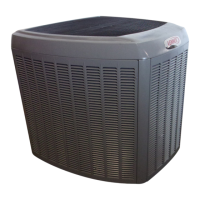
